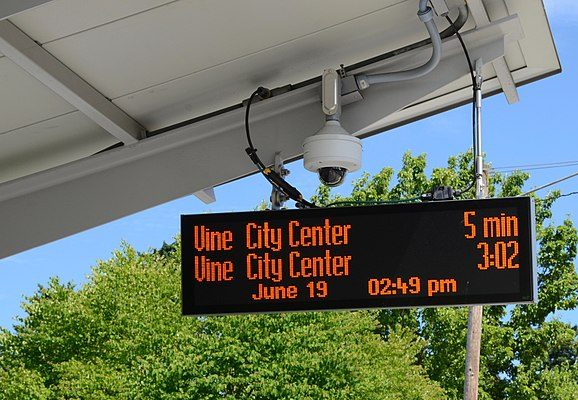In what appears to be the largest investment of its kind in U.S. history, the city of Houston is installing 3,000 real-time arrival information signs across its bus and rail stations — and giving riders relief from the familiar dread of waiting for a ride that seems like it might never come.
According to a press release from GMV, the transit technology firm contracted to install it, Houston METRO is putting $26 million toward the new signage, which will utilize a combination of multimedia video screens and LED scrolling messages that METRO will be able to update with departure information and service advisories in real-time. Officials are hopeful the move will cut down on missed connections and curry confidence among its 200,000+ average weekday riders.
They also hope it will address a potentially under-estimated factor in rider satisfaction: how the human brain perceives wait times, particularly when we’re not confident in how long that wait will be. Research shows that without real-time arrival information, a ten minute wait for the bus can easily be experienced as twenty.
“If you go to a dentist's office, the reason they have a fish tank is because they're trying to give you some sort of entertainment because we feel like time passes slower when we're waiting for things,” explains UC Davis Engineering Professor Kari Watkins, who researches how transit wait times affect transit systems’ perceived (un)reliability, and how technology like real-time arrival screens can change those perceptions. “And in transit, this is a huge problem because there's a lot of waiting involved in making a trip.”
Houston’s signage announcement comes just three months before the Federal Transit Administration announced it will require all transit agencies operating fixed routes to report their “General Transit Feed Specification” (or GTFS) data, which could pave the way for more agencies to follow their lead. Originally short for Google Transit Feed Specification, GTFS is the open source data that powers apps like Google Maps, Transit, and Moovit, as well as agency-maintained real-time arrival screens.
Watkins acknowledges that many riders may not really need real-time arrival signs if they have a transit app in their pocket — and that in some ways, smartphones have advantages over signs.
“The question was, ‘If it's in the palm of your hand, as opposed to up on the signs, is it going to have the same effect?’” Watkins recalled. “And basically, all that you're learning from the paper was yes, it has the same effect. But the cool part was it also meant that people waited at stops [for] less time in actuality. So it's not just like they feel like they're waiting less time, but they don't even go and stand at the stop if they have really great information in the palm of their hands.”
Watkins argues, though, that real-time signage will still make a major difference for riders, particularly those who don’t have smartphones or unlimited data plans. For users of the 65 percent of transit agencies without public GTFS, meanwhile, loopholes in data procurement processes are still holding agencies back from getting riders the up-to-the-minute data they want.
“Data may seem like a wonky topic, but quality data translates to real improvements for riders, and real pain for them when it’s not there,” said Aaron Antrim, co-founder of the passenger communication systems company Trillium, a division of Optibus. “Reducing car dependence is 100 percent about eliciting behavior change. That is one of the most difficult problems to solve. GTFS are tools to ensure the services on the streets have a ‘common language’ which can be built upon to ensure good information is in the hands of the public.”
But will widespread signage and greater access to GTFS data draw in new riders? Watkins doesn’t necessarily think so. While she argues that real-time signage will make existing riders feel more satisfied, she doubts that drivers passing by newly souped-up bus stations will suddenly rethink their commute.
“[Real-time signage’s impact] on actual ridership is fairly minimal,” Watkins said. “Unless you have an excellent transit system to begin with … You've got to have the base service there. The main reason most people don't take transit is that they're not willing to plan their whole day around a bus that only comes every half an hour — or, in some cases, every hour.”
Still, Antrim thinks GTFS data will help riders make the best of imperfect transit systems.
“In the absence of enough funding to guarantee five or 10-minute headways everywhere, knowing when your bus will arrive is the difference between trusting the bus is going to get you to work, or not,” Antrim said.






